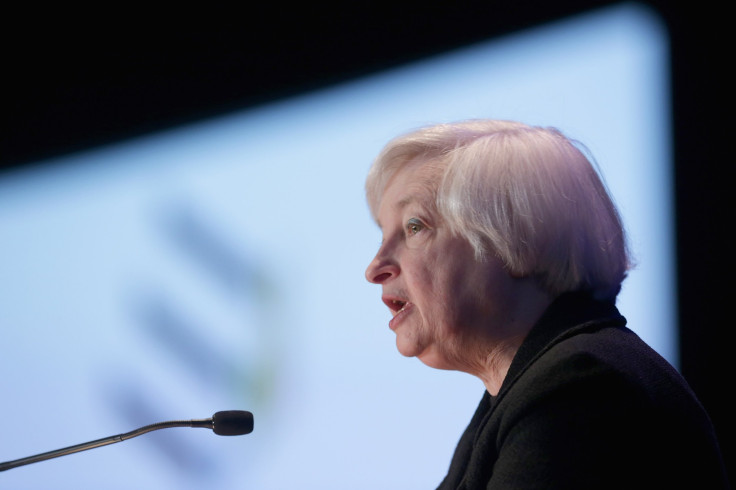Federal Reserve System: 5 Things To Watch From FOMC Meeting, Janet Yellen Speech

Financial markets are bracing for a highly anticipated announcement from the U.S. Federal Reserve Wednesday that will shed light on when the central bank plans to increase interest rates. The Fed has held rates at historic lows since the financial crisis began in 2008, primarily to boost the economy during the recession.
But the Fed has signaled recently that it could begin returning interest rates to normal levels sometime this year, which would mark the first rate hike in nearly a decade. When the rate hike comes, it will have broad effects on the U.S. economy and consumers, as windows of opportunity narrow on financial deals -- including low mortgage refinancing rates and zero percent financing on credit cards.
The Federal Open Market Committee (FOMC) is scheduled to release a statement Wednesday at 2 p.m. EDT, followed by a press conference from Federal Reserve Board Chair Janet Yellen at 2:30 p.m. EDT.
Here's what to watch for during the Fed's announcement.
1. The Fed’s Evolving Rhetoric
Most economists anticipate the Fed will raise rates in September. But that only leaves one meeting in July between now and then, meaning if the Fed is going to raise rates soon, their statement has to evolve in today's announcement. “They can’t exactly wait until the meeting before to have a statement that’s truly indicative of a forthcoming rate hike,” said Greg McBride, chief financial analyst at Bankrate.com.
The Fed dropped the word "patient," from its statement in March, signaling that the U.S. central bank is one step closer to ending near-zero interest rates. The move gave the Fed the option -- but not necessarily the obligation -- to raise interest rates at its discretion throughout this year.
Since the removal of the word “patient,” the committee has introduced a new phrase in its speeches: the central bank needs to have “confidence in the outlook” that inflation will return to the 2 percent target. “They’re really telling us in an indirect way that they’re going to be very cautious before raising rates,” said Robert Hughes, Senior Research Fellow at American Institute for Economic Research.
2. Fed’s Economic Projections Could Signal A Liftoff
The Fed will also release its updated projections for the U.S. economy over the next three years. Economists are likely to hone in on two key details: growth in the gross domestic product (GDP) and inflation.
Economists say the Fed is unlikely to tie itself to a specific rate hike date, but the release of its updated quarterly growth, unemployment and inflation forecast, along with Yellen's post-meeting press conference, will provide plenty of guidance. “While we do not expect a rate liftoff, we do hope to gather some insights as to the timing of future rate hikes,” Gregory Daco, chief U.S. economist at Oxford Economics, said in a research note.
3. Inflation
The Fed’s outlook for inflation has been dropping, according to the FOMC's March economic projections. Inflation is forecast to come in at 1.3 or 1.4 percent -- below previous forecasts -- but economists expect it to move closer toward the Fed’s 2 percent target over a multiyear period. “Overall, we don’t see inflation as a major threat,” said Hughes.
Most markets believe the Fed will definitely hike rates in 2015 regardless, especially after Yellen's warning last month that delaying action to tighten monetary policy until U.S. employment and inflation reach the central bank’s targets would risk overheating the economy.
4. A Second Quarter Rebound
Economists are also watching to see if Yellen acknowledges recent reports that showed improvement in the economy. The Fed chair recently noted the slowdown in the U.S. economy during the first three months of the year may just be “statistical noise,” due to weather and West Coast port disputes.
The economy looks set to rebound this spring, despite its lackluster first quarter. The economy shrank 0.7 percent in the first three months of the year, but economists are forecasting a likely growth at a rate between 1.5 percent and 3 percent for the April-June period.
5. The Fed Doesn’t Want to "Rock the Economic Boat"
Another key part of the FOMC's summary of economic projections to be released with the policy decision statement is the “dot plot,” which shows where each participant in the meeting expects the federal funds rate will be at the end of the year and includes data for the next few years as well.
Policymakers signaled a less aggressive path for rates by lowering interest rate estimates for the end of the year following their meeting in March. The median projection for where interest rates will be at the end of the year fell from 1.125 percent to 0.625 percent in March, meaning the Fed's forecasts could give them room to lift rates twice this year from the current near zero level of 0.25 percent.
However, a significant downward turn in the committee’s dot plot could signal that the Fed only will increase rates once this year. This indicates that the current committee will take a more gradual approach to lifting rates -- unlike the Fed committee from 2004 to 2006, who raised interest rates 17 consecutive times. “Instead, this is a Fed that will raise rates once and then sit back for a few months and make sure they didn’t rock the economic boat by doing so,” McBride said.
© Copyright IBTimes 2024. All rights reserved.






















